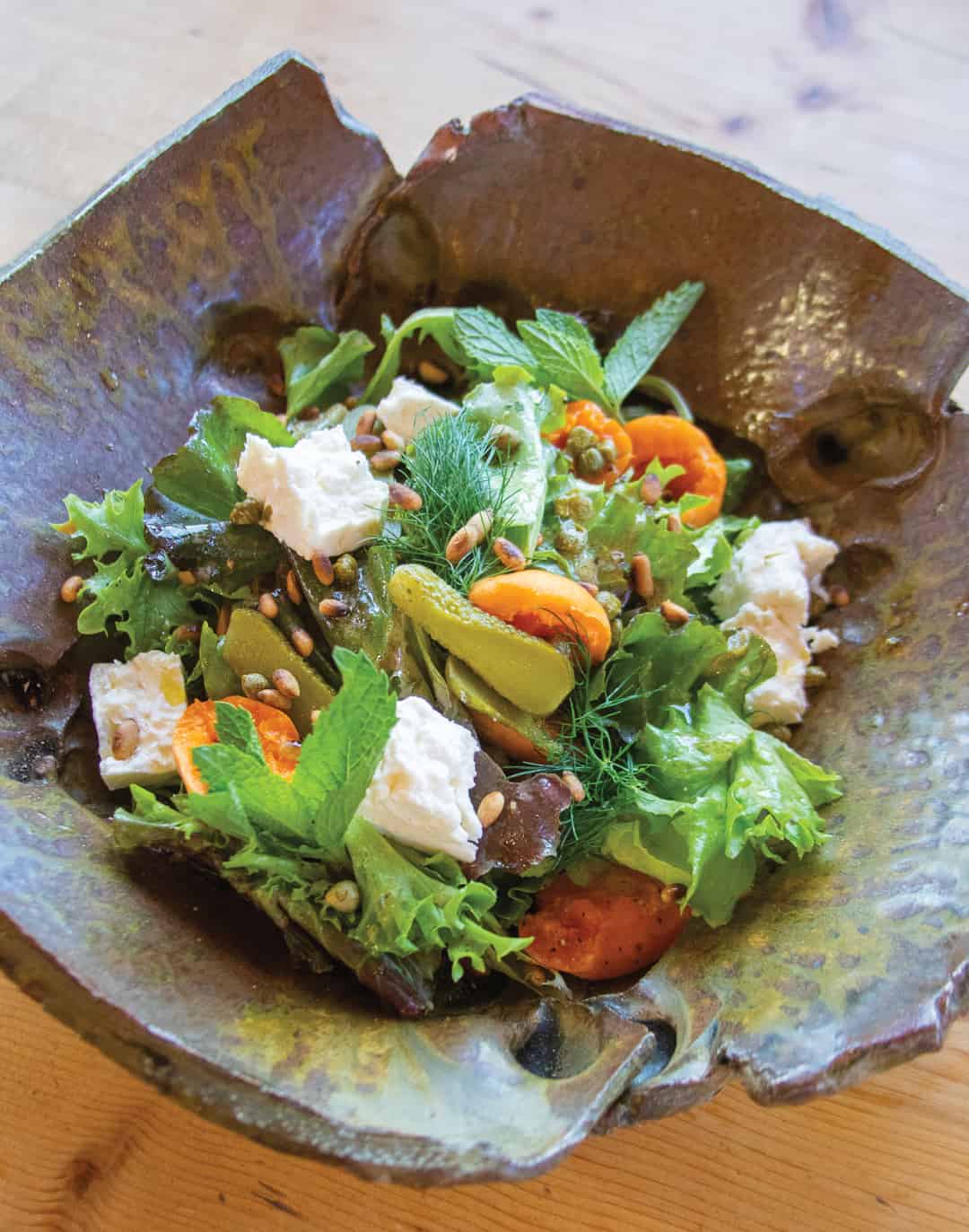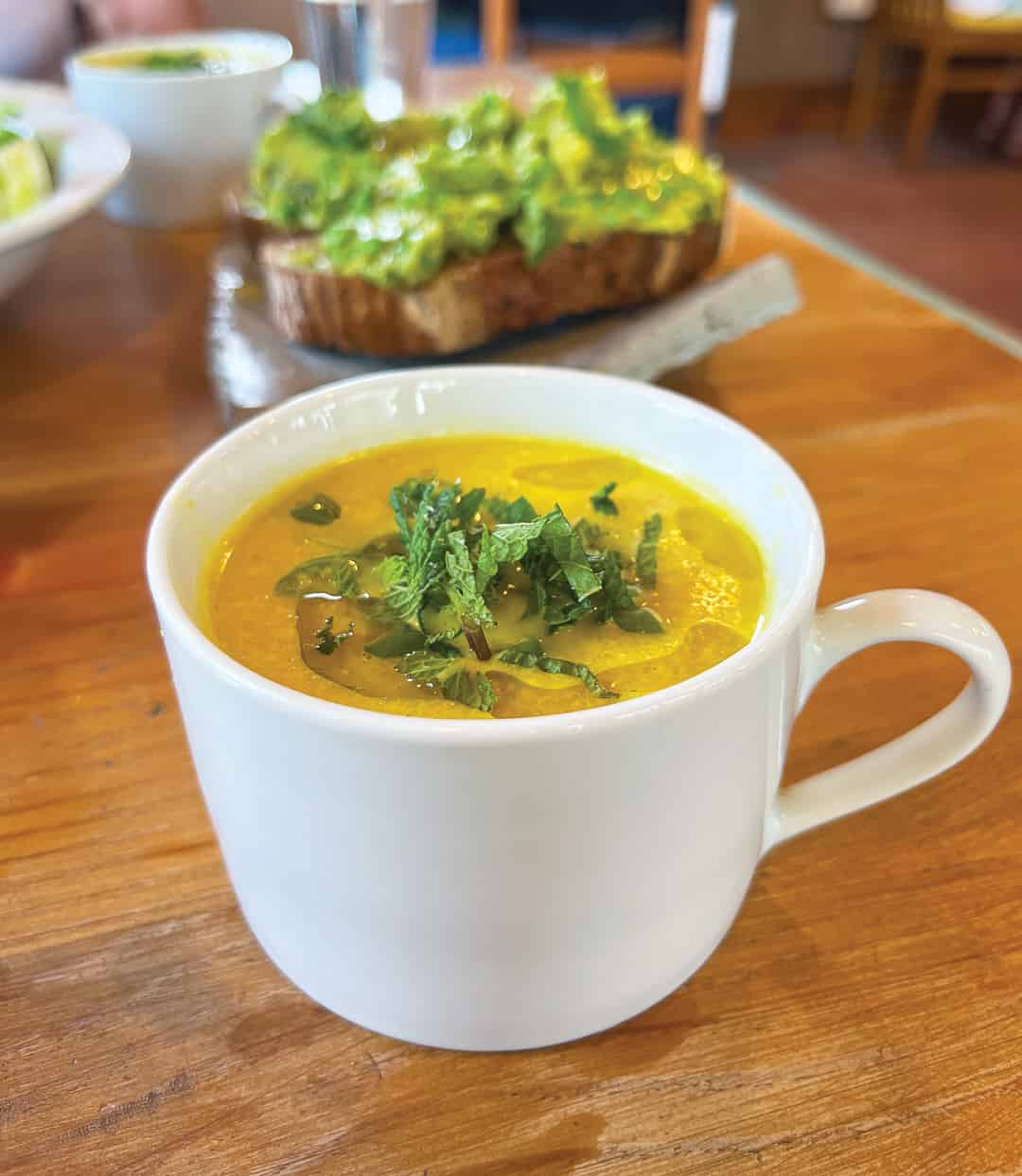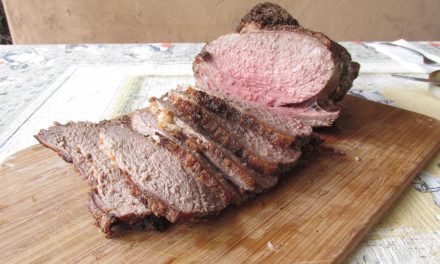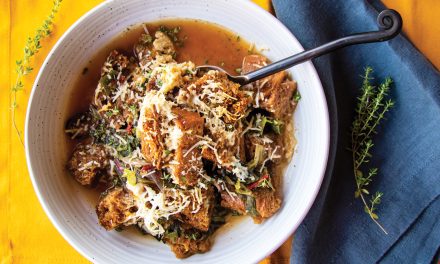Lunch at Santa Fe’s Worst-Kept Secret
By Candolin Cook ∙ Photos by Stephanie Cameron

Chilled cucumber soup with dill.
A few days ago, I mentioned to a friend that I was writing an article about The Kitchen at Plants of the Southwest. Only half-joking, she replied, “Could you not?” For over a decade, the seasonal restaurant has been called Santa Fe’s “best-kept secret.” However, fear that this article might let the cat out of the bag is probably unwarranted, since nearly everyone in town already seems to know and love it.
Nonetheless, this “hidden gem,” as it is also often described, does have an air of mystery about it. Its limited capacity and hours (one seating, Thursday–Saturday, April–October) makes scoring reservations difficult. Its vegetarian prix fixe menu changes daily. And its unique location, tucked away at the Plants of the Southwest nursery, makes it feel like a private lunch club. To eat at The Kitchen, book a reservation by texting its chef-owner, Olive Tyrrell, well in advance. Once you arrive at the nursery, follow the winding dirt path past rows of outdoor tables teeming with native plants (purple prairie clover, penstemon, cacti), beyond the sunny and stylish storefront, and finally to the one-room adobe farmhouse situated at the back of the property. At precisely noon, the restaurant’s glass doors will swing open, revealing a minimalist interior with rustic wood beams, brick floors, a charming open kitchen, and a dining room consisting of several two- and four-tops surrounding a large communal table.

Emelie Richardson and Olive Tyrrell.




Top left: Beep Beep Bakery bread. Bottom left: Seasonal salad. Top right: Brown butter plum cake. Bottom right: Fig walnut bread with whipped feta and dill.
On the balmy June afternoon I visited, the set menu began with a refreshing cup of gingery gazpacho made with summer squash, fresh corn, and yellow heirloom tomato, and topped with a chiffonade of fresh herbs and a drizzle of olive oil. Soon after, a heaping farm salad arrived family style. The delicate salad greens came dressed in a light and tart vinaigrette and tossed with a colorful assortment of pickled peppers, cornichons, capers, currants, and sliced apples and nectarines. The leisurely paced third course featured a thick slab of toasted rye bread slathered with smashed avocado and peas and a sprinkle of fresh mint—and was served on a ceramic plate made by Tyrrell. The components of each dish exuded freshness, peak flavor, and the bounty of summer.
Tyrrell crafts her daily menu based on what local farmers and purveyors have available. “We want to support as many farms and local producers as we can,” she says, citing a roster that includes Western Family Farm, Ground Stone Farm, La Capilla Hops Farm, and Beep Beep Bakery. “I plan ahead weekly and then let myself free-fall. I often change the day’s menu the morning of or during service, based on what I have or how I’m feeling. I’m an intuitive cook, and like to experiment in the moment.” Too, she values the interplay between the food and the plate, sourcing ceramic works from local potters in addition to creating them herself. “I believe the act of eating and drinking from handmade objects creates an even more profound dining experience,” Tyrell tells me.
The chef cut her culinary chops working in various restaurants in San Francisco for nearly two decades, but it wasn’t until she joined forces with Gail Haggard, owner of Plants of the Southwest, in 2009 that she was able to establish the kind of restaurant she wanted to helm. “We [both] wanted an uncomplicated, unfussy, vegetarian lunch spot that focused on locally grown food,” Tyrrell says. The collaboration with Haggard has “evolved over time,” she says, but their original vision has endured and proven mutually beneficial. “I think the benefits between the nursery and restaurant are sharing customers and furthering the discussion on plant-based foods and inspiring people to invest in the native plants that Gail provides.”


Left: Gazpacho with summer squash, fresh corn, and yellow heirloom tomato. Right: Toasted rye bread with smashed avocado and peas.
Tyrrell has also found a symbiotic relationship with in-house baker and server Emelie Richardson. Richardson follows a seasonal pattern with her desserts and incorporates many fruits and plants harvested on site. “Olive and I are both visual artists, and I think this was fundamental in creating a successful collaboration with one another in the kitchen,” she says. “I was immediately attracted to the way in which Olive approaches food; she truly sees it as another art medium in which to express herself. Her dishes are uniquely hers and are always approached from an intuitive place. Working alongside her continues to inspire not only the way I bake but so many other aspects of daily life.”
In addition to the inspiration Richardson receives from Tyrrell, she says she enjoys the meditative process she finds working in a space surrounded by native plants, and “the general magic that exists in Gail’s nursery.” At meal’s end, she shared some of that magic in the form of a hearty slice of strawberry torte served with a scoop of vanilla ice cream. The decadent and perfectly baked dessert was a satisfying way to end such a nutritious lunch.
When I later ask Tyrrell about her personal food philosophy, I’m delighted that the vegetarian chef offers a more permissive spin on Michael Pollan’s oft-quoted advice, “Eat food. Not too much. Mostly plants.” “My food philosophy is to give pleasure,” she says. “Food is pleasure for me. Feeding people is to give joy and nourishment. To eat well, to eat more plants, and to indulge as well.” This certainly seems like a secret worth sharing.
3095 Agua Fria, Santa Fe. Pro tip: Text ahead to reserve at 505-913-1911; cash or check only.
Candolin Cook is a historian, writer, editor, and former co-editor of edible New Mexico. She recently received her doctorate in history from the University of New Mexico and is working on her first book.


















